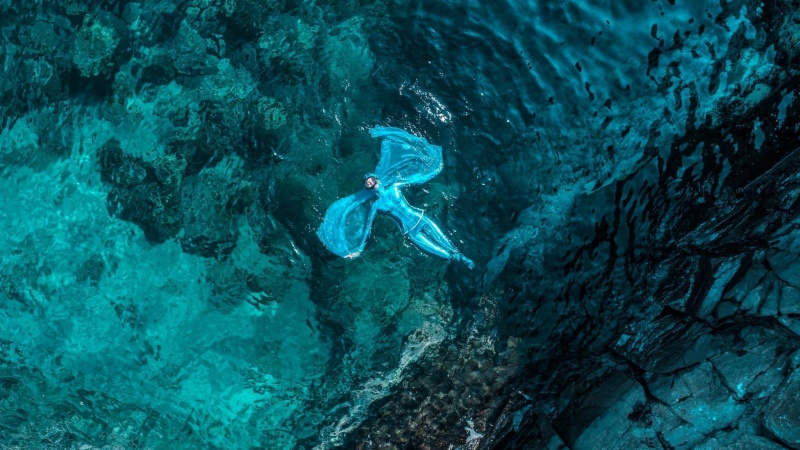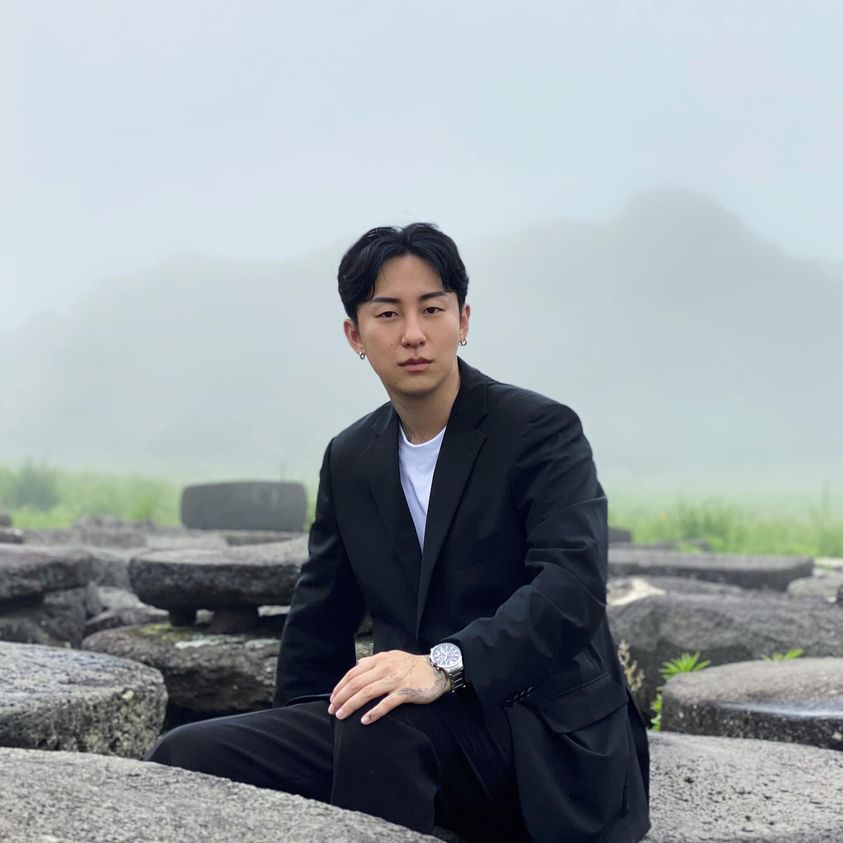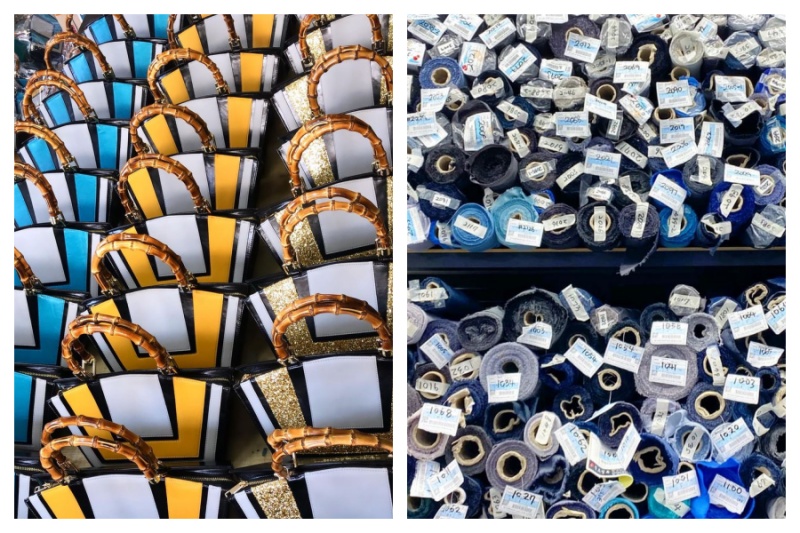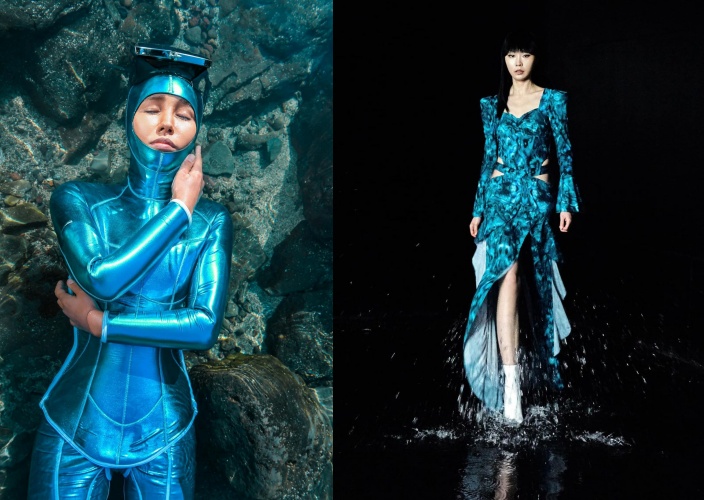- 한국어
- English
- 日本語
- 中文
- العربية
- Español
- Français
- Deutsch
- Pусский
- Tiếng Việt
- Indonesian
By Honorary Reporter Dianne Pineda Kim from Philippines
Photos = Park Lyn Jun

Designer Park Lyn Jun's creations are inspired by the haenyeo and the beauty of Jeju Island.
Fishing, once the main livelihood on Jeju Island, used to be a male-dominated industry until the haenyeo (female divers) began diving for food to feed their families. Staying in the water for six to seven hours a day to collect seaweed, shellfish and other seafood, the divers are considered early trailblazers of female empowerment in Korea. They symbolize determination, strength and hard work, making them one of Jeju's treasures. Koreans refer to them as "mothers of the sea."
In 2016, UNESCO recognized the legacy and history of the divers as Intangible Cultural Heritage. Today, their way of life is dying as the haenyeo are aging and few young people are willing to take over given the risks of the job.

Designer Park Lyn Jun is a native of Jeju Island.
Fashion designer and Jeju native Park Lyn Jun seeks to reignite interest in the divers and find inspiration from them. He started his fashion brand Pale Turquoise to promote the beauty of the island and Jeju's mysteries. Just as he creates fashion to revive the dying haenyeo tradition, he uses niche marketing to revive and protect the oceans.

Park says his designs are based on sustainable, zero-waste and eco-friendly practices.
With his goal of preserving the haenyeo and Jeju's nautical treasures, he launched the Haenyeo Clothing Research Institute, which produces high-quality Korean-made diving suits for the divers and contemporary diving wear for all.
The following are excerpts of an interview with the designer.
Why is Jeju Island important to you when making your designs?
Born and raised on Jeju Island, I came to Seoul to study fashion design. The biggest difference between me and other designers in Seoul was my hometown. The island has inspirations other designers cannot easily find, and I have great interest and a sense of accomplishment in reflecting Jeju in fashion.
How did you start your brand?
Before starting the brand, I took pictures of the street fashion of Jeju locals. I studied the island's fashion and identity for a long time, and have learned the history and culture of Jeju to reflect them in fashion.
Your brand's concept is inspired by nature and eco-friendly. Can you elaborate on this?
The name Pale Turquoise symbolizes the foggy jade sea and the mysterious scenery of Jeju Island. Eco-luxury is the brand concept I'm aiming for. I want to show the pure and magnificent beauty of Mother Nature as seen on the island and create eco-friendly yet luxurious products. The keywords "eco," "zero-waste" and "upcycling" are not popular now but I want to put them into practice.

What message do your haenyeo-inspired designs have?
I found out that the diving suits worn by Jeju haenyeo were made in Japan. I think it's better that they wear suits made from Korean-made materials instead of Japanese. So I launched the Haenyeo Clothing Research Institute to create better and more practical suits to protect them while diving for more than seven hours. I want to improve their uniform and make it with domestic material. I'm also planning to create diving suits for all in Korea.
You opened a street fashion market on the island. How has that gone?
In the downtown area of Jeju City, dozens of sellers hold a fashion market once a month and earn around KRW 10 million won a day. Like the streets of Hongdae in Seoul, many flock to the market.
What message do you want to send to young people, many of whom are unfamiliar with Korean traditions, through your designs?
Leaving Jeju to work in Seoul and China, I badly missed my hometown and felt its special power. The keyword "local" will gradually become a trend, so young Koreans should do R&D of where they grew up. By championing locally made products and talent, we can be globally competitive.
How should Korean traditions that are gradually disappearing be preserved through fashion?
Fashion is a huge industry with events that can mobilize huge infrastructure. People in the sector should conduct more exchanges with other professionals such as historians and scientists. An old Korean proverb says "Learn from the old to make the new," so we must maintain traditions while developing and creating from them. I hope to see more historians and scientists in fashion.
enny0611@korea.kr
*This article is written by a Korea.net Honorary Reporter. Our group of Honorary Reporters are from all around the world, and they share with Korea.net their love and passion for all things Korean.